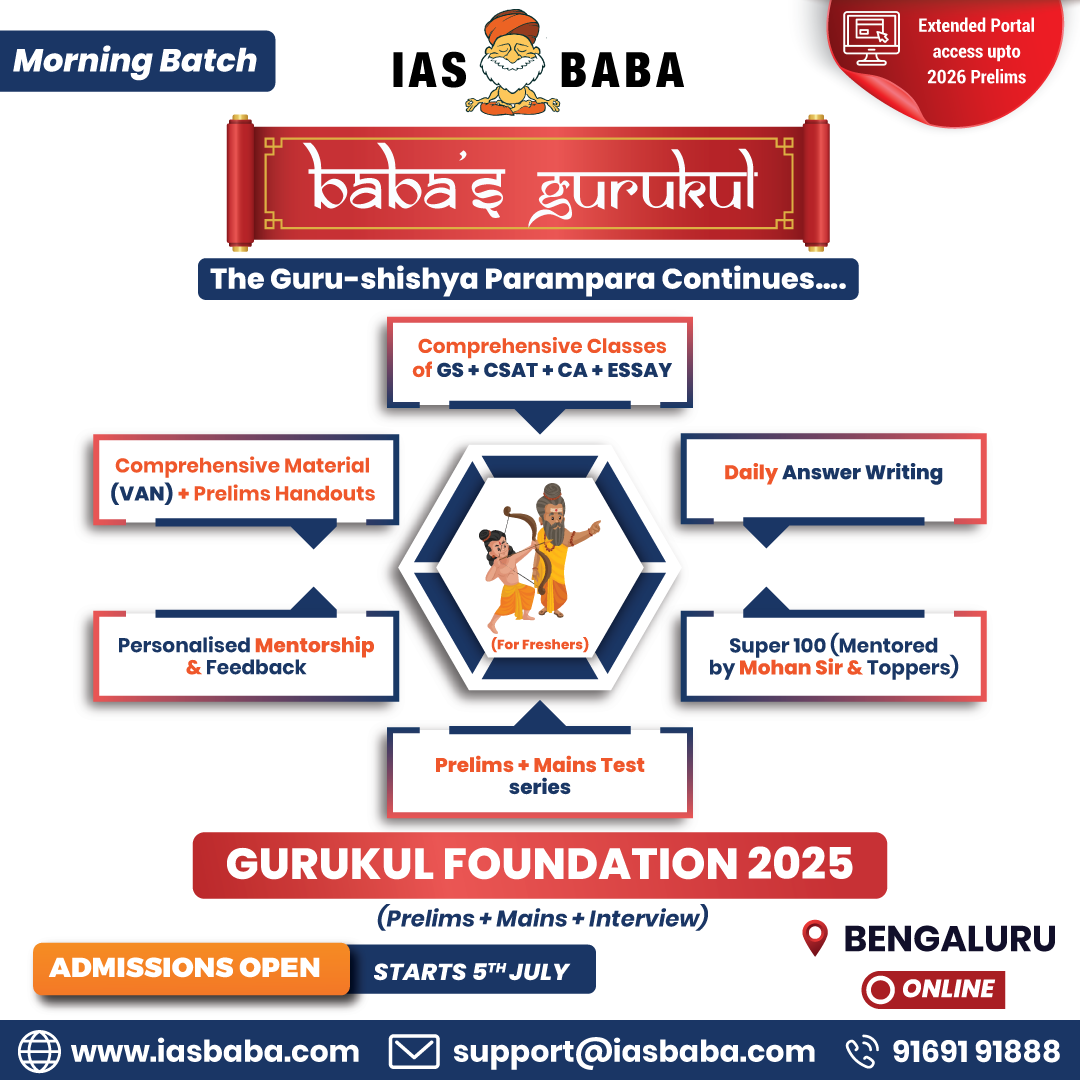Question Compilation, TLP-UPSC Mains Answer Writing
For Previous TLP (ARCHIVES) – CLICK HERE
SYNOPSIS [9th NOVEMBER,2020] Day 25: IASbaba’s TLP (Phase 2): UPSC Mains Answer Writing (General Studies)
1. Do you think India’s multilingual society creates social and political tension? Critically comment.
Approach – It expects students to write about India’s multilinguistic aspect in its social spectrum, and critically analyze whether multilingual society creates social and political tension.
Introduction
Indian multilingualism dates back historically to ancient times when ethnic groups and races came in contact with one another through migration from one region to another. Political compulsions and social re-structuring might have contributed a little to its growth, multilingualism in India was largely a product of close contact between the language families from the earliest recorded history.
Body
Multilingual society creating social and political tension:
- North-south divide: There is a north-south divide mainly due to attempts of imposition of Hindi as the link-language of India. Opposition to Hindi as a national language from representatives from southern states was fierce. When 1965 came around, the debate on national language had transformed into a movement against Hindi imposition.
- Narrow and parochial outlook: Politicians, possessing narrow and parochial outlook and certain regional political parties create linguistic feeling among the people of a locality and exploit their sentiments at the time of election and in matters of various political issues.
- Politics with Language-in-Education: The centre’s order in April 2017 making Hindi compulsory in all Central Board of Secondary Education (CBSE) affiliated schools till the secondary level evoked various responses. Some asserted that the policy was contradictory to the right to education, which gives the student the right to choose their set of languages.
- Regionalism: Linguism has promoted local identity. The regional differences have come in the way of national integration. Extreme sense of regionalism has resulted in parochialism and ethno centricism.
- Exploitation of people by Politicians: Language has evoked psychological and emotional feelings among people. Politicians are promoting the spread of only particular languages through monetary inducements. They exploit the sentiments of people at the time of election.
- Erosion of national feeling: Linguistic loyalty has come in the way of national integration. Thus, interstate boundary dispute, river dispute has become common. Example Difference of opinion among people speaking Kannada and Marathi in Belgaum.
- Demand for separate states: Extreme sense of Linguism has caused linguistic conflicts. Such conflicts are quite often supported by politicians. For Example, Demand for a separate state by people of “north Karnataka” region.
- Threat to sovereignty: Linguism is posing a severe threat to the integrity of the country. On the basis of language people have become more self-centred without thinking of the progress of the country. In Some states the regional language is being used even for administrative purposes, which causes a major problem to people who do not belong to that particular state.
- Language based dominance: Usage or prominence of a particular language often reflects the dominance of one community in the Indian society. For example, Sanskrit, most of the times has been associated with the dominance of Brahmanism in society.
- Purity notion: The idea of ‘purer’ forms of language and its distinction from ‘dialects’ propagates the influence of a particular caste or community which marginalises all the other ‘impure’ forms.
- English based discrimination: While English is considered a language, which is devoid of caste conscious vocabulary, it is also known as the language of educated elites and has created a new class divide. Majority of the jobs being created in India, particularly in the service sector are dominated by English language speakers.
Linguistic based political and social agitation in society has different functional benefits:
- Creation of state which are homogeneous in nature improved the functioning of the state and govt. has been able to better connect with the masses in the language in which they understand. For ex. creation of Gujarat from Bombay resulted into betterment of people.
- The Division of states linguistic basis removed the major discord and disharmony among people. For ex. separation of Andhra from Madras addressed the agitation and protest by Telugu people.
- It led to creation of state regional parties which can raise their voice in the Parliament. Hence, a more cooperative federalism and participative democracy thrived epitomizing unity in diversity.
- It provided opportunity to the states to protect and promote their regional language which brought satisfied cultural aspiration of masses. For ex. recent adoption of Odia language as official language by Odisha.
- Dravidian and anti-Hindi movement in South India, which opposed caste-based society and Hindi was also seen as a language that perpetuates a ‘backward’ culture of caste and gender oppression.
Conclusion
Linguistic diversity has been a critical aspect of the multiculturalism that has been the defining characteristic of India through the ages. Diversity is undoubtedly strength of our democracy. The cultural bonds need to be strengthened through enhanced and continuous mutual interaction between people of varied regions. This encourages reciprocity and secures an enriched value system of unity amongst people of different States.
2. What do you understand by professional code of conduct? Is it always good to
act as per one’s professional code even if it contradicts the conscience of a person? Examine.
Approach – It expects students to write about professional code of conduct in the first part and write about situations in which conscience contradicts with one’s professional code with appropriate example.
Introduction
Codes of conduct represents the set of enforceable rules that should be followed by a person in an organisation. Codes, along with other measures, have helped some companies dig themselves out of scandals, and have helped many companies build a healthier work climate and reputation.
Body
Professional code of conduct:
- Ethical principles underpin all professional codes of conduct. Ethical principles may differ depending on the profession; for example, professional ethics that relate to medical practitioners will differ from those that relate to lawyers or real estate agents.
- However, there are some universal ethical principles that apply across all professions, including honesty, trustworthiness, loyalty, respect for others, adherence to the law, doing good and avoiding harm to others and accountability.
- Professional codes of conduct draw on these professional ethical principles as the basis for prescribing required standards of behaviour for members of a profession. They also seek to set out the expectations that the profession and society have of its members.
- The intention of codes of conduct is to provide guidelines for the minimum standard of appropriate behaviour in a professional context. Codes of conduct sit alongside the general law of the land and the personal values of members of the profession.
Contradiction between professional code of conduct and conscience:
- Soldiers on the border have to follow orders from their command even if it doesn’t suit their conscience. As it is necessary to avoid create larger issues of breakdown of organisation’s functionality.
- Conscience is the part of your mind that tells you whether what you are doing is morally right or wrong. It is based on personal set of values which may differ person to person. However, code of conduct is devised for the larger institutional objectives for optimal functioning.
- It is often necessary to follow professional code of conduct to avoid questions about legality of action. To fulfil needs and demands of the profession.
- However, sometimes following professional code might create crisis of conscience. Crisis of conscience is time when someone is worrying because they think that they have done something unfair or morally wrong. It may demoralise the individual and lower her spirit.
- E.g. if economically distressed patient need admission in private hospital but she doesn’t have required money to deposit before admission in emergency situation, following code of conduct may result into refusal to the patient while following conscience by management or doctor might save life of patient, which is larger objective of health services organisation.
Conclusion
Conscience is beyond law; it focuses on following spirit of law rather than sticking to letters of law. Even in the civil services, experience over a period of time suggests there is need of code of ethics along with the code of conduct to realise mission to serve people.
3. Is it possible to differentiate between ethics in private and public life? Critically
Examine.
Approach
It is strait forwards question, where it expects student to write about – in first part, how ethical standard are found to be different while in second part, mention how ethical standards that should be similar in both private and public life.
Introduction
Each private and personal relationship has its own irreplaceable value. Each of it has its own unique history, character, and set of implicit and explicit understandings about what is to be expected of the parties to it. Individuals should be ethical in both private and public relationships. In doing so, they should also try to achieve a right balance between private and public ethics.
Body
Ethical standards are found to be different for private and public life:
- Choosing private interests: When it comes to private interests, individuals tend to act with personal motive and are ignorant of its effects on the public as a whole.
- Openness and transparency: Private lives are influenced by closed choices, secretive decisions and emphasize privacy whereas public lives delve on openness and transparency and hence render more accountability to one another.
- In private life, ambitions and goals, constraints and difficulties, of an individual sometimes result in a compromise of values.
- Freedom of choice enables the individual to make quick choices suited for them, sometimes even foregoing ethical values, just to achieve the end result in a faster pace.
- Public relationships are more instrumental such as organizational colleagues, politicians, strangers, and others outside of one’s relatively narrow circle of intimacy. It is the action of getting along with people we constantly come in touch with whereas private life is almost completely based on what the individual thinks is right.
- Example: Keshub Chandra Sen opposed child marriage but married his own underage daughter to Maharaja of Cooch Bihar. Consequently, his followers abandoned him and founded Sadharan Brahmo Samaj (1878). Thus, if there is inconsistency in the public life and private life of a person, it leads to disastrous outcomes.
However, some ethical standards that should be similar in both public and private life:
- In both public and private life, an individual should have a sense of moral obligation in the interest of overall welfare of everyone around, and not resort to extreme actions which destroy the harmonious fabric.
- Virtues of compassion, cordialness, basic civic sense etc. are important in any sphere of life, and help one’s wholesome growth as both a private individual and a peer in general.
- In both private and public spheres of life one should have highest sense of integrity and not be influenced by any outside individual or organization which might affect their performance.
- Both have to have utmost honesty and sincerity in their actions and both have to take steps to resolve any conflicts arising in a way that affects their respective private and public lives.
- Example: Following fundamental duties by an individual like respecting national flag, not destroying public property, protect environment, wildlife etc. should be done irrespective of private or public space.
Conclusion
Some ethical values should be followed in both spheres of an individual irrespective of the consequences, and some are based on their matter of influence over the individual’s life. Nevertheless, any action by an individual must be logical and work on self-betterment and contribute to the larger welfare of the public life he/she is involved in.
4. Co-existence of spiritualism and materialism is a sui generis Indian social characteristic. Elucidate.
Approach – As the directive here is elucidate a cause effect relationship is given in the question. Here it is expected to bring out the connection more clearly by citing evidence and examples. The term sui generis indicates ‘uniqueness’. Here, it is expected to show how coexistence of spiritualism and materialism is a unique Indian social characteristic.
Introduction
When we speak of Spiritualism, we are usually talking about a life with inner peace. Spiritualism means dropping of the greed. Materialism means exactly opposite where one goes for continuous accumulation of assets till the end of life. As both the ‘ism’ are exactly opposite to each other, they are believed to exist on two different poles. However, that is not the case with India, where spiritualism and materialism co-exist in a society.
Body
India is popularly known to be a land of spirituality, particularly to the West. However, Indian history from ancient times to the present day shows that the developments of materialistic and non-materialistic culture have been going on alongside. Following are the features due to which it is observed that Co-existence of spiritualism and materialism is a sui generis Indian social characteristic.
- Spiritualism provides a foundational philosophy based on which a person looks at her life in a very different way. For instance, I am happy when my family, friends and society is happy. This little thought is prevalent in India. Which shows that emotion of happiness has more value than acquiring money, property. Which shows that though materialism exists in Indian society, spiritualism also exists in parallel.
- One of the reasons for co-existence of spirituality and materialism is the poverty in India. For instance, the spiritualism comes in to picture when a person seeks peace of mind or a break from stressed daily routine. Continual existence of poverty and a will to come out of poverty makes people more hardworking. For instance, many of the people in India wish to come out of the vicious economic cycle posed by poverty. In order to do so their nature and character of work changes from healthy work environment to stressed work environment. Which leads them to turn to spiritualism to come out of this stressed environment.
- In terms of Buddhist philosophy, a term called ‘suffering’ has to be looked in detail. When people achieve what they want they become happy. But this happiness is temporary. When they again feel stressed up, they turn towards spirituality. For instance, the tradition of Vipassana observes followers from varied backgrounds. It is of no surprise that most of the people belong to so called rich class which has acquired humongous wealth. It shows how those who professed and cherished materialism now continue to live their life with spirituality.
- The verse of ‘Karmnyewadhikaraste ma Faleshu kadachan’ from Bhagwadgeeta, is itself a manifestation of what we call the coexistence of spirituality with that of materialism. Here, Lord krishna is suggesting a way of life for people who are living a materialistic life should have a spiritualistic point of view.
- The Charvaka school of thought is the main profounder of materialistic view to achieve salvation. They argued against the need to achieve the salvation. They propounded that living in this life contended with what we achieve is the real salvation that one can achieve. They propounded that enjoying the worldly pleasures is the real salvation. However, it didn’t happened in India, as many people have not completely adhered to this philosophy.
- One of the reasons for coexistence of both the philosophies is the Indian value of ‘tolerance’. Which is the core element of Indian civilisation. Indian society believes in the philosophy of ‘live and let live’. Hence, the value of tolerance forms the one of the foundational values on which spiritualism and materialism co-exist.
- The geographical extent of India also plays a prominent role in maintaining co-existence of spiritualism and materialism. For instance, India is surrounded on its three sides by water and in the north lies the giant and wide range of Himalayas. This geography made India vulnerable to different disasters. Which led people to be more spiritual. However, only being spiritual in life will not help hence practically material culture also prevailed to sustain in life.
- Social Interdependence: One of the great themes pervading Indian life is social interdependence. The social interdependence has paved the way for coexistence of spiritualism and materialism. For instance, People are deeply involved with others, and for many, the greatest fear is the possibility of being left alone, without social support. This social interdependence has created a situation where people respect others views and neglect what hampers this social interdependence.
- Merger of Traditions with modern system: Globalization might have bought with it a surge of modern values and practices, but traditionalism is still prevalent and preserved in India. Which led to co-existence of spiritualism with materialism.
- The Underlying Theme of Unity in Diversity which is the basis for the continuance of culture in India. Indian society has challenged the scepticism of many political thinkers post-independence that were doubtful regarding India’s amalgamation as one nation amidst vast differences and big numbers of ethnic groups, languages, culture and diversity. For instance, we observe Mutual celebration of religious festivals despite religious differences, and the rise of Cosmopolitan culture in metros.
- The Indian society has survived in the face of diversity, thanks to its accommodative values of tolerance and mutual respect that have existed from the early times. The co-existence of various philosophies including atheistic, religious and materialistic, symbolizes the society that must have existed in those times.
- It’s not just about the values and principles cherished in our history. But our constitution also supports the coexistence of Spiritualism with materialism. For instance, our preamble grants liberty of thought, expression, belief, faith and worship besides not prohibiting anyone from acquiring a private property.
Hence, it can be said that, some people in our neighbourhood are some of the most materialistic people. However, there exist some very spiritual people in India too. Buddha took the path of enlightenment because of the prevalent materialism in his age. Hence, it is right to say that materialism and spiritualism co-exist in India.
Conclusion
In a general observation over the globe it is observed that materialism rules the world. However, India forms to be an exceptional example where spiritualism and materialism co-exist in society. This co-existence is not only sui generis of Indian social characteristic but also a way of life where people live in a harmonious society of diverse thoughts and practices.
5. Segmental division of the India society is a complex social phenomenon. Do you agree? Critically comment.
Approach – It expects students to write about segmental division of Indian society i.e. Jati system. With critically analyzing it write about how its complex social phenomenon and its changing nature.
Introduction
The society is divided into various segments of small and big social groups. Each of these segments are a well-developed social group. In India caste system is the major segmental division of the society, as in ancient India it was four-fold segment but in later days it became highly complex social phenomenon that is called jati.
Body
The Segmental division of Indian society is highly complex, which is reflected from the following points:
- Number of Jatis – There are perhaps more than 3000 jatis in India and there is no one all-Indian system of ranking them in order of status.
- Occupation based on jati – Each jati has some unique job, but not everyone in the jati performs it. Thus, there are barbers, carpenter, and Brahmins.
- Based on local phenomenon – A jati is identified in a local setting by whom its members will accept food and water from and to which jatis its members will give food and water. Different jati have different social status in different villages or region.
- Jati as dynamic – The jati system is not static in which all groups stay in the same position. There is mobility in the system and jatis have changed their position over the centuries of Indian history. A jati can improve its position in the class system by advancing economically and emulating social groups with money and power. For example, Sanskritization and Westernisation.
- Mythical account of its origins – Each jati typically preserves a mythical account of its origins and a distinctive set of life-cycle rites observed by its members. Each is overseen by a local council that oversees and enforces a set of rules governing, and acceptable occupation.
- Many competing hierarchies – Castes that are lower down the scale do not accept the degrading status accorded to them. Caste arithmetic in politics designed to show that caste alliances emanate from secular and political factors and not from primordial loyalties. Hierarchies that may then develop are an expression of politico-economic power and may change with alterations therein.
- Jati-class overlap – New socio-economic realities taking on new and insidious forms jatis with different type of class upper lower and largely middle class.
- New identities and associational forms – Formation of caste associations such as Jat Sabha. Rise of jati politics across country makes sure that caste as a system is not forgotten.
It was the Britishers who messed up this system completely their census fixed a jati somewhat arbitrarily in some Varna. Though there are many ill-effects of the jati system, it has positives and simple unified implications also, some of which are discussed below –
- Such as social resilience and social capital.
- A flexible system of jati where occupational value determines its market price was a good idea. An ossified system still seems to be functional, and can disappear with urbanization.
- Kinship and trust are the bases of these jati-based networks. People are much more liable to trust those whom they have kinship with, and willing to loan them small amounts of money. And that trust is almost never violated, because excommunication would be intolerable.
- It was the best device to organize within one society people of different cultural levels. It prevented the country from splitting up into warring racial units. It integrated Indian society into one vast and variegated community and provided the country with a sure basis of security and continuity whereby a stable and orderly organization of society could be possible.
- It has fostered the spirit of co-operation and fellow-feeling among members of the same jati. By helping the poor and needy, it minimises envy or unhappiness.
Conclusion
Considering that jati offer solidarity and psychological strength to various jati groups, even if the jati-based discrimination is diffused through the legislative enforcement the divisions of identity will be difficult to erase. Political will is the need of the hour. This would make sure that caste-based politics are reduced. Awareness has to be created among adults. Also value based education emphasising on equality must be inculcated to young minds.















